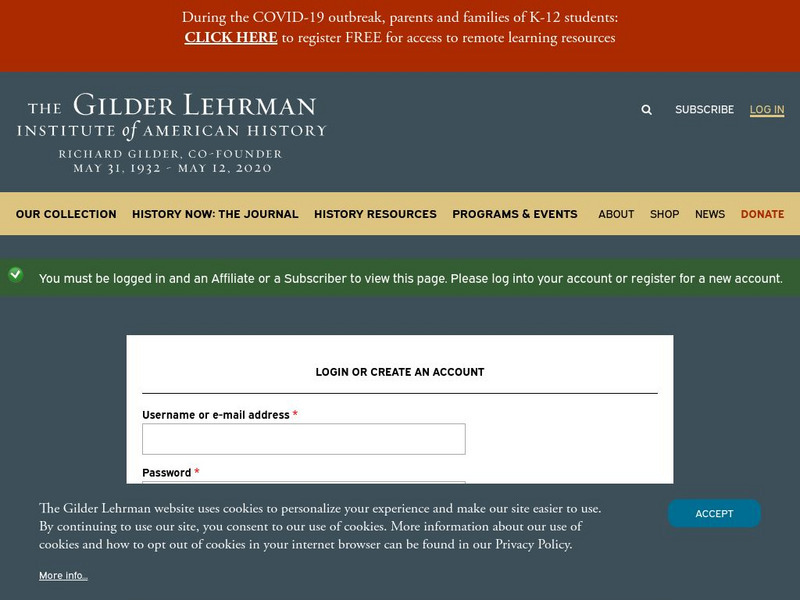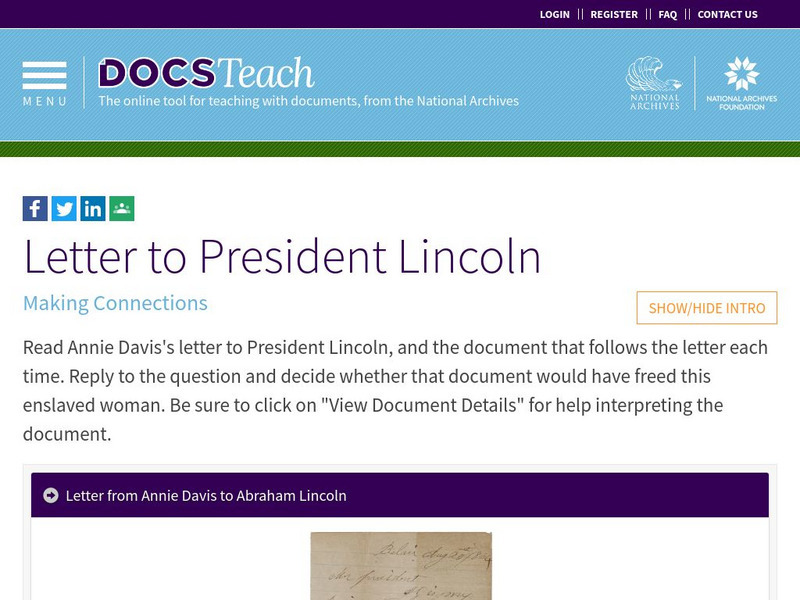Curated OER
What are the 13th,14th, and 15th Amendments?
The 13th, 14th, and 15th Amendments are outlined in this PowerPoint. Each amendment is noted on its own slide, with a summary of its purpose and important sections of the actual document. Tip: Have students choose an amendment and write...
Library of Virginia
Emancipation and the Thirteenth Amendment
Why didn't the Emancipation Proclamation free all slaves? Young historians study primary source documents including Lincoln's proclamation and the 13th Amendment to the United States Constitution. Groups also investigate the three...
Curated OER
Amendment Organizer
In this Amendments worksheet, students describe the 13th, 14th, and 15th amendments and write which one they feel is the most important.
Curated OER
The Called Themselves the K.K.K.; The Birth of an American Terrorist Group
How did Ku Klux Klan develop and flourish in the US? How did the government respond to acts of terrorism conducted by the KKK following the Civil War? How does the government respond to acts of terrorism today? This resource...
Curated OER
Writing Exercises: Science and Technology II
All revolutions in science and technology have both pros and cons. Kids examine the advent of the green revolution, nuclear growth, use, and the countries that are considered nuclear powers. They'll construct three responses to each of...
Roy Rosenzweig Center for History and New Media
Reconstruction
When slavery ended, what did the government do to help African American during Reconstruction? An interesting instructional activity uses primary sources such as newspaper articles to help scholars analyze Reconstruction policies and how...
State Bar of Texas
Dred Scott v. Sandford
Who decides someone is not a real person? Scholars investigate the Dred Scott v. Sandford court case which deals directly with slavery and citizenship. After viewing a short video clip, classmates work in pairs to assess and discuss the...
Curated OER
Constitution/Impeachment/Reconstruction
Eleventh graders analyze a chart comparing U.S. census data from 1850, 1880, 1900, and 1920. They read a handout summarizing immigration legislation from 1882-1996 and create a graph charting how open / closed U.S. immigration is over time.
Curated OER
With malice toward none, with charity for all: The life of Abraham Lincoln
Students research Abraham Lincoln in a variety of ways. In this Abraham Lincoln lesson plan, students use primary sources, vocabulary activities, books, and more to research and learn about Abraham Lincoln.
Curated OER
The Complexities of Reconstruction
Fourth graders critically analyze the social, economic, and political impact of the Federalization of the South. They develop a PowerPoint presentation relative to the Post Civil War South.
Curated OER
All That Sparkles is Silver!
Students analyze photographs for information about life in Virginia City Nevada in the late 1800s. In this Nevada statehood instructional activity, students work in teams to analyze photographs from Virginia City. Students brainstorm...
Curated OER
The Right to Remain Resilient
Pupils examine the Civil Rights Movements in the U.S., both current and historic. In small groups students investigate a specific civil rights group, create an illustrated timeline, noting key events, people, and state and federal laws.
Curated OER
Segregation in Prince Edward County
Eleventh graders examine the history of integration as it applied to Virginia high school in Prince Edward County. They evaluate a map of Virginia counties, read and analyze a first person narrative of a young girl involved in a boycott...
US Government Publishing Office
U.s. Government Publishing Office: Thirteenth Amendment [Pdf]
Complete text of the thirteenth amendment of the United States Constitution.
Gilder Lehrman Institute of American History
Gilder Lehrman Institute: The Reconstruction Amendments
[Free Registration/Login Required] An article that discusses the 13-15th amendments and their impact on social history.
US National Archives
Docsteach: Letter to President Abraham Lincoln From Annie Davis
Students will study a letter from Annie Davis, a woman who was enslaved in Maryland and wrote a letter to President Abraham Lincoln during the Civil War to find out if 'we are free.' The students will decide if she received her freedom...















![U.s. Government Publishing Office: Thirteenth Amendment [Pdf] Primary U.s. Government Publishing Office: Thirteenth Amendment [Pdf] Primary](https://static.lp.lexp.cloud/images/attachment_defaults/resource/large/FPO-knovation.png)

